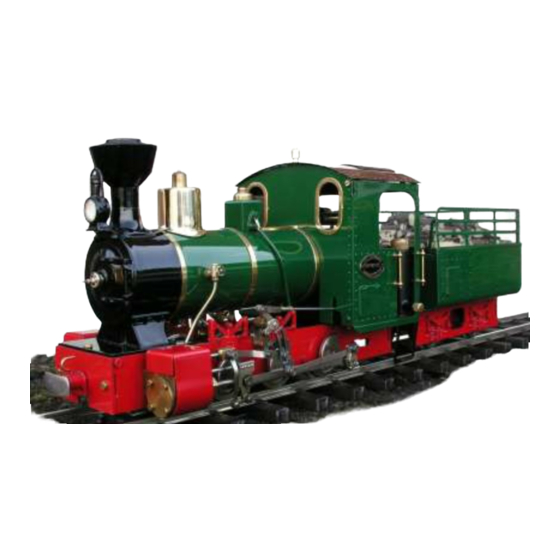
Table of Contents
Advertisement
Quick Links
Advertisement
Table of Contents

Subscribe to Our Youtube Channel
Summary of Contents for roundhouse roundhouse WILLIAM
- Page 1 WILLIAM Owners Handbook...
-
Page 2: Operating Instructions
Operating Instructions IMPORTANT: Read these instructions carefully before operating the locomotive The following items are required for running this engine and are not in- cluded with the model. Fuel Butane gas. See 'Filling the gas tank' Water See 'Filling the boiler' Lubricating oil See 'Lubrication' SAFETY PRECAUTIONS This is a working model locomotive using steam under pressure and... -
Page 3: Table Of Contents
William Instruction Booklet CONTENTS Tool kit Page 4 Running in Page 4 Access to controls Page 4 Identification of parts of the locomotive Page 5 Preparations for operation Page 6 1. Filling the Gas Tank Page 6 2. Filling the Boiler Page 6 3. -
Page 4: Tool Kit
TOOL KIT The following items are included with your locomotive. One 60m1 bottle of special steam oil for use in the cylinder lubricator. One 60m1 syringe with plastic tube for filling the boiler with water. One set of spare washers and ‘0’ rings. One spare gas jet. -
Page 5: Identification Of Parts Of The Locomotive
IDENTIFICATION OF PARTS OF THE LOCOMOTIVE Radio controlled version illustrated 1/ Lubricator drain screw. 2/ Lubricator filler cap. 3/ Reversing servo, this is replaced by a reversing lever on manual models. 4/ Pressure gauge. 5/ Gas regulator. 6/ Gas tank. 7/ Gas filler valve. -
Page 6: Preparations For Operation
A special brass gas filler adapter is obtainable from your local garden railway supplier or direct from ROUNDHOUSE. Mixed gasses are also available and may be used if ordinary butane or iso- butane are not available, but see ‘Gas System’... -
Page 7: Lubrication
There has to be a space above the water to allow steam to be raised so, insert the end of the plastic pipe into the boiler and withdraw 30ml of water with the syringe. Replace the filler plug finger tight. 3) LUBRICATION Regular lubrication of all working parts is important and should be carried out before each operating session. -
Page 8: Lighting The Burner
4) LIGHTING THE BURNER WARNING: Before lighting read the section on gas system troubleshooting (page 13) and be aware of potential problems. If the gas system is not operating correctly, shut it off immediately or damage may result. Move the locomotive to another location before lighting. Butane is heavier than air and small pockets of gas can collect around the locomotive during filling. -
Page 9: Running The Locomotive
RUNNING THE LOCOMOTIVE When full working pressure has been reached (about 40psi), the safety valve will start to blow off steam. Steam generation can be controlled by the gas valve in the cab. If the safety valve blows off frequently during running, then too much steam is being produced, which wastes water and gas. -
Page 10: Driving By Radio Control
regulator a little. Initially, there will be a certain amount of water in the pipes and cylinders, which will exhaust through the chimney and, after a few moments, the engine will move jerkily, until this clears. Once the parts have warmed up, the engine will move off steadily and it's speed can be controlled with the regulator. -
Page 11: Storage Between Operating Sessions
transmitter batteries are housed in the back of the unit under a clip off panel. The receiver batteries are housed in the tender as described on page 3. STORAGE BETWEEN OPERATING SESSIONS At the end of an operating session, it is good practice to clean the locomotive carefully with a clean soft cloth, and to oil all bright metal parts. -
Page 12: Trouble Shooting & Maintenance
TROUBLE SHOOTING & MAINTENANCE On a working model of this nature, it is important to keep all working parts well lubricated. With constant heating up, cooling down and the stresses of hard work, screws etc. can work loose so, it is good practice to check all fixings and cylinder screws regularly but remember, never over tighten. -
Page 13: Gas System
TX or RX. When fitting, ensure that the one marked TX is fitted to the transmitter and RX to the receiver. Two radio systems are currently in use, 40MHz FM and 75MHz FM. ROUNDHOUSE now only use 75MHz FM sets for USA and CANADA. Ensure that the replacement crystals are of the correct type. - Page 14 Slacken the screw retaining the jet block and slide it out to the rear. Remove the jet from the jet block using a 4BA spanner. Wash out the jet in fast evaporating thinner (Cellulose or similar). Blow through the jet from the front, which should clear most blockages.
- Page 15 Gas Burner 1). Superheater Pipe. 2). Lubricator Pipe. 3). Gas Jet Block retaining screw. 4). Gas Jet. 5). Gas Jet Block. 6). Gas Pipe. 7). Gas Burner fixing screw. 8). Air Inlet Holes.
-
Page 16: Service And Parts
ROUNDHOUSE William, with Coal Load If your dealer is unable to help, you may contact the Factory directly: ROUNDHOUSE ENGINEERING CO. LTD. Units 6-9 Churchill Business Park. Churchill Road. Wheatley. Doncaster. DN1 2TF. England Telephone 01302 328035 Fax 01302 761312 e-email support@roundhouse-eng.com...














Need help?
Do you have a question about the roundhouse WILLIAM and is the answer not in the manual?
Questions and answers